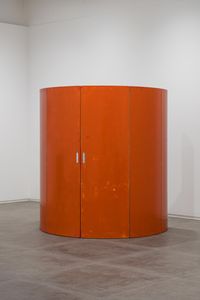Charles-Édouard Jeanneret, also called Le Corbusier, was a highly influential and innovative Modernist architect, theoretician, and city planner known internationally for his highly sculptural buildings, precise modular design, and fanatical passion for a universal Modernist utopianism.
Read MoreBorn and raised in La Chaux-de-Fonds, a Swiss village in the Jura Mountains near the French border, with his father an enameller and mother a piano teacher, Le Corbusier had an aptitude for art. In this watchmaking town he went to the local art school which taught the applied arts. The art teacher, a painter, persuaded 16-year-old Le Corbusier to take up architecture. He educated himself by using libraries, museums, sketching, and building houses with two other students under the supervision of his architecture lecturer. Together in 1905 they built a chalet in the forest for a local engraver. Its success led to two more buildings.
In 1907 Le Corbusier travelled to Florence, Budapest, Vienna, and then Paris where he worked for architect Auguste Perret as a draughtsperson for 14 months. Perret was a pioneer in the use of reinforced concrete. Le Corbusier then worked in Germany with Peter Behrens, who introduced him to Walter Gropius and Mies van der Rohe. After more travel in Europe he returned to Switzerland and built an innovative house for his parents, the Jeanneret-Perret House (1912) and larger commissions followed.
During the First World War, he researched in Switzerland new structural possibilities for reinforced concrete, working with an engineer Max Dubois on a new system of slabs, columns, and stairways where the method of weight distribution was not visible from the outside, even with glass walls. Le Corbusier built the Anatole Schwob House in 1916, combining reinforced concrete with brick, and with his cousin Pierre Jeanneret formed a working partnership after moving to Paris in 1917.
Between 1918 and 1922 he was encouraged by his friend, the Purist painter Amédée Ozenfant, to only paint, and to theorize about architecture for their joint publication L'Esprit Nouveau. He then embraced his nickname, Le Corbusier, created because of his crow-like (le corbeau) demeanour and his grandfather's name (Lecorbésier), and formed a new studio with Jeanneret and Charlotte Perriand.
In planning a model city to present at Paris Salon d'Automne in 1922, they proposed a provocative design for 60-storey high apartment blocks, lower zigzagging versions, and a park. Published in book form the plan was accompanied by a functionalist mantra, 'A house is a machine to live in', as if a dwelling were an aircraft.
In 1925 Le Corbusier presented a L'Esprit Nouveau Pavilion for the International Exhibition of Modern Decorative and Industrial Arts in Paris. Influenced by architect Adolf Loos, in the accompanying publication Le Corbusier vehemently attacked decorative art as 'a dying thing,' and advocated mass-produced cells, uniform standardisation, elegant austerity, and machine-made furniture. A later Plan Voisin had Parisian suburbs demolished to be replaced by high cruciform tower blocks positioned in a grid of streets, and a multi-levelled transportation hub.
Completed individual buildings from this time that demonstrate Le Corbusier's ideas include Weissenhof Housing Project, Stuttgart (1927); Villa Savoye, Poissy (1928–1931); and The Villa La Roche-Jeanneret (now Fondation Le Corbusier), Paris (1923).
Of these, Unité d'Habitation (1947–1952) was an implemented plan for war-damaged Marseille, a Cité Radieuse for 336 duplex modules, each two storeys high.
Le Corbusier was also contracted to design Chandigarh, India (1951–1956), transforming it into the spectacular Brutalist capital of Punjab. 'A city of trees, of flowers and water,' it features long promenades, gardened terraces, and enormous honeycombed government buildings.
Le Corbusier's chapel, Notre-Dame du Haut (1955), in Ronchamp, France, is much loved for its sweeping curved white walls, bulging roof, and intricately grouped, deeply sunk windows. A marvel of religious architecture, it is revolutionary in form, and steeped in sculptural feeling.
John Hurrell | Ocula | 2021




